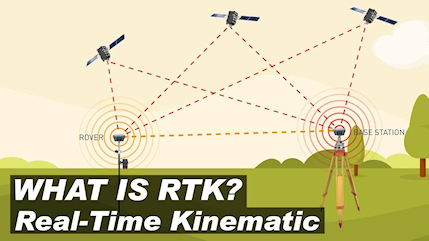What is RTK?
RTK stands for Real Time Kinematic positioning. It’s a technology that can enhance a standard GPS signal and transform its resolution from a few meters to a few centimeters.
The way RTK works is by having a fixed base station of known position. The thing that needs to have a precise position, can be referred to the rover. The base station calculates correction data from the carrier signals sent from the satellites. Then, the base station sends these real-time correction signals to the rover, enhancing the precision of the rovers position. For a deeper explanation please refer here.
RTK and robotic mowers
Robot mowers have been around for a while now. They continue to use a variety of methods to navigate themselves around lawns. Lots use a guide wire that is placed around the perimeter of the lawn (known as perimeter wire). This wire has a current pass through it, which the robot can detect. The polarity tells the robot whether it is on the inside or the outside of the lawn boundary.
The simplest robots of this type use the following ‘algorithm’:
What other technologies do robots use?
Lots of robotic mowers also use the perimeter wire in conjunction with other technologies, such as radar, GPS, visual terrain analysis etc to assist in making the mowing as accurate and efficient as possible.
Many of these technologies don’t allow the robot to mow linearly, however, and the robot movesin a random profile across the lawn. RTK is precise enough to allow the robot to mow in a blockby block fashion, with each block being no larger than 5x5cm.
Advantages and disadvantages to RTK
What is RTK? Is a perfect question to ask in the context of robot mowers. It’s a fantastic technology that really brings down the scale of measurement, enhancing the efficiency of robot mowers. It is not without its own disadvantages though. RTK technology works best with unobstructed skies, so the base station can measure the carrier signals and relay the correction signals to the mower effectively. This means that RTK equipped robotic mowers are more suitable to wide open spaces rather than lawns surrounded by trees and buildings like those found mainly in residential settings.
Find out more about RTK today
To find out more about RTK equipped robotic mowers then visit the innovative manufacturer Ambrogio here.






